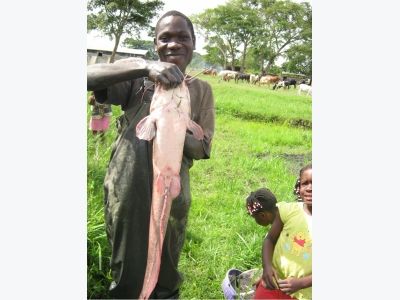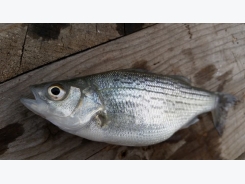Investing in Africas aquaculture future, part 2

‘Patient capital,’ collaboration and a little charisma needed to grow SME operations across the continent‘Patient capital,’ collaboration and a little charisma needed to grow SME operations across the continent
A Ugandan farmer with catfish broodstock, photographed in 2011 by Anton Immink.
For investors and entrepreneurs undaunted by a challenge, Africa represents a chance to pioneer – to build an industry, essentially from scratch. With that opportunity comes great risk, for some of the principle business barriers the continent is known for – inferior (or absent) currency controls, accounting standards or tax regimes, not to mention infrastructure deficiencies – add up to too many unknowns for some to get involved.
Randall Brummett, senior aquaculture specialist for the World Bank, advocates a different approach than many of the existing “incremental investments” favored by governments and non-governmental organizations that claim to improve workers’ incomes by as much as 20 or 30 percent. But if those wages are as low as $1 a day?
“That’s not alleviating poverty, it’s just sort of moving it around,” he said.
The World Bank is setting up a fund with the help of the European Union to support aquaculture in Africa, an initiative that Brummett said has moved significantly forward, partly because aquaculture is an easier business model for private sector investors to evaluate than capture fisheries. The fund would also apply to other natural resource-dependent sectors like tourism.
“For aquaculture, the door is more or less open. The basic policy for aquaculture in Africa is, ‘Yeah, we want some.’ But Africans have been arguing for years that it needs to be commercial scale,” said Brummett, who shared details of the World Bank’s Blue Economy Roadmap Initiative (BERI) and scaling public-private partnerships for equitable and sustainable development.
World Bank favors a long-term (25-year) plan to align investors and other stakeholders, diagnose failures and underperformance in the sector, and develop plans for growth while alleviating poverty and preserving critical ecosystems. “Africa wants visible impacts that make a difference in poverty. And that’s what the World Bank wants,” he added.
BERI summarized that aquaculture in Africa is:
- In many cases, growing too slowly, and often unsustainably, relative to the need
- A fragmented industry, with few new entrants
- Subjected to limiting, “mission-critical” capital needs
- In need of creative analytical tools applied to risk mitigation and growth acceleration
- Lacking a systematic financing model.
“Local banks’ interest rates are too high and their turnover time is way too short. If you need to order a container of feed, you can do that through a commercial bank,” said Brummett. “But you’ll pay 30 percent interest, and they’ll want their money back in 12 to 18 months probably. It’s not the kind of patient capital that you need to grow a business.”
With a tepid private equity climate and unfavorable local bank loans, a number of SMEs in Africa turn to the World Bank for financing because in many areas the legal system is still evolving, and transactions are not always 100 percent transparent, said Brummett.
“Some of the aquaculture companies come to us for political protection. Having a little bit of World Bank coverage helps,” he said. “If you’re operating privately, sometimes you have political problems. If you’re doing well, you might have government people at your door wanting to charge taxes, inventing new taxes, asking if their brother can have a job, that kind of thing.”
The triple-bottom-line approach
Impact investment – benefitting economic, environmental and social well-being – is what Aqua-Spark, a Netherlands-based investment firm has aimed to do since its founding in 2013. It has two African properties in its rapidly growing portfolio, including the Chicoa Fish Farm growing tilapia in Mozambique and Indian Ocean Trepang, a sea cucumber farm in Madagascar. Each farm works with smallholders in their respective communities to build their own businesses. Indian Ocean Trepang already has a budding export business with customers around the world.

Workers at the Chicoa Fish Farm. Photo courtesy of Aqua-Spark.
CEO Mike Velings told the Advocate that Aqua-Spark intends to do “much more” in Africa, and soon, but did not reveal specific details of new ventures. At the World Aquaculture Society meeting in Cape Town, Managing Partner Amy Novogratz announced that the firm – in conjunction with investors Msingi – would soon launch a dedicated investment fund for Africa worth $17 million. Its aim: to build infrastructure for a “thriving sub-Saharan aquaculture sector.”
Velings isn’t deterred by what isn’t there, at least in terms of roads, energy and distribution and storage facilities. Instead, Velings said the risks associated with investing in aquaculture operations in Africa currently stem from a paucity of options to invest in.
“The issue is, if you’re going to invest, you have a handful of companies [to choose from] and that’s it,” he said.
As a result, attractive outfits often have a relatively high price tag, he said, compared to what can be found in more mature markets like Asia and Europe. That means investors might be forced to jump into a business a bit earlier in the life cycle than they wish to, or are accustomed to.
“Having to get involved earlier, from the ground up, maybe, that’s where the extra risk comes from,” he added. “You have to be more patient. You need to be a bit more flexible than usual. If you have a good eye for a deal, and have a long-term outlook with maybe the infrastructure not in place but you can help build it, it’s a really exciting space to be in – knowing there are some bumps in the road ahead.”
One of those bumps could be found in the very workforce that appears as one of Africa’s strengths. While there is great demand for steady employment, many people in regions of Africa have never held full-time jobs before.
“The basic thing about showing up to work every day can be an issue. Managing your staff, and the relations of the local community is all very ad hoc,” said Brummett.
Scaling up modest investments
Despite the numerous challenges of developing successful, commercial-scale aquaculture businesses in Africa, there are success stories to be found. Brummett surveyed nearly 20 active farms in Africa and the results illustrated how small and medium-scale enterprises (SMEs for short) currently dominate the sector, with an average projected capital expenditure and operating expenditure (CAPEX and OPEX) of just $4.4 million. The ventures in the survey ranged from $40,000 to $19 million.
“I’ve been told that there are at least 100 more similar companies. Most are under 1 million,” Brummett said. “Right now, the first- or second-biggest farm – Tropo in Ghana – started with just 1 million.” The amount could have been half of that, he added, but mistakes were made. “Mistakes are part of being a pioneer.”
In Zambia, a company founded in 2011 named Yalelo was started in Lake Kariba by U.K. investor Adam Taylor. Farming tilapia in cages like those used to raise Atlantic salmon in northern oceans, Yalelo is growing its tilapia business and earlier this year became a major client of a 50,000-metric ton feed mill being under construction by Danish aquafeed producer Aller Aqua. The partnership is expected to soon push Yalelo’s production past 30,000 MT a year.
In Kenya, Victory Farms was recently dubbed “Africa’s fastest-growing fish farm” by seafood trade publication IntraFish, which wrote that the company’s tilapia production in Lake Victoria will reach 2,000 metric tons by next year.
South Africa’s government launched the project “Operation Phakisa” this summer, an initiative to nearly triple farmed fish production by 2019. Currently producing mussels, abalone and trout, among other species, the ambitious plan – Phakisa means “hurry up” in the Sesotho language – is backed by University of Stirling (U.K.) and the United Nations’ Food and Agriculture Organization (FAO).
Someday, in some parts of Africa, the aquaculture industry may resemble what Asia has achieved. But Asia, Brummett noted, had advantages: By moving aquaculture into rice fields, operators could take advantage of existing irrigation canals. Much of the physical infrastructure transformation in Asia – digging ponds and canals, building roads and facilities, connecting production areas with distribution channels – was done for less money than Africa will require, with a lower cost of entry for new participants.
Africa is “not a place where you can replicate models easily,” said Brummett, “not like Asia, where even though they have highly variable practices at the farm level, the basic species they grow was very similar, and the water management was the same so it was very easy to just copy aquaculture.” In Africa, land is commonly governed by traditional authorities, and separate deal are necessary for access, putting one more obstacle in the way.
“You can get in. The guys who are doing it are making money. But it takes a lot of charisma. You gotta be able to work with the local communities. If you’re going to get involved as a foreigner, or even as a local guy, you have to do a lot of deals. It’s not a matter of getting a permit and then everyone leaves you alone. The permit’s the easiest thing.”
Related news
Tools

Phối trộn thức ăn chăn nuôi

Pha dung dịch thủy canh

Định mức cho tôm ăn

Phối trộn phân bón NPK

Xác định tỷ lệ tôm sống

Chuyển đổi đơn vị phân bón

Xác định công suất sục khí

Chuyển đổi đơn vị tôm

Tính diện tích nhà kính

Tính thể tích ao



 Can aquaculture flourish in a more symbiotic sea?
Can aquaculture flourish in a more symbiotic sea?  Fisheries and aquaculture: Sister activities with a common…
Fisheries and aquaculture: Sister activities with a common…